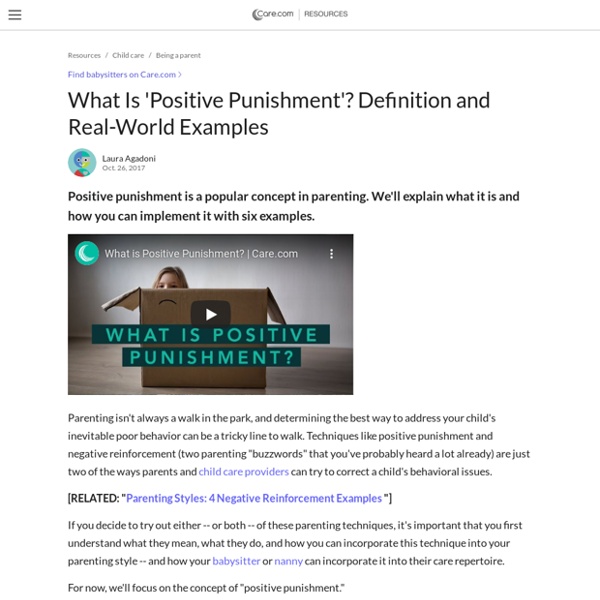Article 1: "The Study of Punishment in Psychology"
Punishment is a term used in operant conditioning to refer to any change that occurs after a behavior that reduces the likelihood that that behavior will occur again in the future. While positive and negative reinforcements are used to increase behaviors, punishment is focused on reducing or eliminating unwanted behaviors. Punishment is often mistakenly confused with negative reinforcement. The difference: Reinforcement increases the chances that a behavior will occur and punishment decreases the chances that a behavior will occur.
Punishments vs. Consequences: Teach Your Teen the Difference
When I work with parents of teenagers, our conversations inevitably turn toward discipline. “How do get my teen to follow the rules?” “My teen won’t clean up after himself. What should I do?” “Nothing I do seems to have any effect on her!”
How to Properly Use Reinforcement and Punishment - North Shore Pediatric Therapy
Reinforcement and punishment are common terms that most people have heard of and use on a daily basis, whether they realize it or not. Although the concepts seem easy to understand and implement, it can be easy to confuse the basic principles and/or implement them incorrectly. In order to understand the difference between reinforcement and punishment, it is important to understand the definitions of both terms. Reinforcement Reinforcement is a consequence following a behavior that increases the probability that the behavior will increase in the future. The consequence can be either positive or negative.
Teens May Learn Best with Positive Reinforcement
A new study finds that adolescents focus on rewards and are less able to learn to avoid punishment or consider the consequences of alternative actions. University College-London investigators compared how adolescents and adults learn to make choices based on the available information. Investigators tracked the way in which 18 volunteers aged 12-17 and 20 volunteers aged 18-32 completed tasks in which they had to choose between abstract symbols. Each symbol was consistently associated with a fixed chance of a reward, punishment, or no outcome. As the trial progressed, participants learned which symbols were likely to lead to each outcome and adjusted their choices accordingly.
Positive Reinforcement: Changing The Behavior of Children For The Better
Home » Positive Education » Positive Reinforcement: Changing The Behavior of Children For The Better “The way positive reinforcement is carried out is more important than the amount.”– B.F. Skinner The purpose of reinforcement is to help increase the probability that a specific behavior will occur when a stimulus is delivered after a response is shown. When people think of reinforcement they immediately think of Pavlov, or at least I do. Pavlov and Skinner studied behavior and noted what it would take to produce a certain kind of behavior.
Article 1: "What is Negative Punishment (Examples and Effectiveness)"
In this article, we will review negative punishment, its definition, examples, and drawbacks. American psychologist B.F. Skinner developed the theory of operant conditioning, which stated that a person or animal’s behavior could be increased or decreased by adding or removing appropriate stimuli after the behavior is exhibited. The difference between classical conditioning and operant conditioning is that classical affects unconscious behavior, while operant affects conscious behavior. Within operant, punishment aims to reduce a behavior while reinforcement increase a behavior. Punishment or reinforcement can be positive or negative.
How Negative Punishment Works
Negative punishment is an important concept in B. F. Skinner's theory of operant conditioning. In behavioral psychology, the goal of punishment is to decrease unwanted behavior.
Reinforcement vs. Punishment: Changing BehaviorBehavioral Health Works
Being a parent has been known as the best thing ever BUT also the most challenging endeavor you will encounter in your lifetime. Parents strive to raise a healthy and happy child that will one day grow up as a full-fledged mature and independent adult. But to successfully accomplish this goal, a parent must set forth structure or rules throughout their childhood to help them understand and be realigned when their behavior needs to be modified. When a parent recognizes the need to change a behavior, they will likely end up using either reinforcement, punishment, or a mixture of both. When we’re helping to decrease the frequency of a child’s negative behavior, having the reinforcement or punishment methods in our toolkit can help you modify and implement the desired behavior.
Parenting Teens: When It Comes To Learning, Positive Reinforcement Trumps Punishment
Teens generally aren’t afraid to defy authority. Generations of parents know this, having tried different strategies for getting their adolescents to do what they ask — often in attempts to keep them safe and help pave a path toward success. Now, a new study shows that rewards, rather than punishments, could be the way to get them to cooperate. Researchers at the University College London asked 18 volunteers aged 12 to 17 and 20 volunteers aged 18 to 32 to complete both a learning task and post-learning task in which they chose between abstract symbols, each associated with a fixed chance of reward, punishment, or no outcome.
Positive And Negative Reinforcement (Examples, Punishment) - Parenting For Brain
Reinforcement and punishment are often used as parenting tools to modify children’s behavior. Let’s review the difference between positive reinforcement and negative reinforcement, and the difference in outcomes between them. The Difference Between Positive And Negative Reinforcement In behavioral psychology, reinforcement is the introduction of a favorable condition that will make the desired behavior more likely to happen, continue or strengthen in the future1. Because the favorable condition acts as a reward, reinforcement is a reward-based operant conditioning. There are two types of reinforcement: positive reinforcement and negative reinforcement.




Positive punishment can be used as a parenting technique to decrease the likelihood of bad behavior in teenagers by introducing an undesirable consequence after an undesirable behavior. For example, a teenage child can be grounded by his or her parent at home for spending excessive time outside home. by jonquah Sep 25